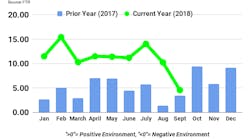Freight-related metrics continue to moderate this fall, according to two industry research firms that track trucking and freight.
FTR’s Trucking Conditions Index for September fell to the lowest level in a year at a reading of 4.58. It is the first time the TCI measure has fallen to single digits since December 2017, and is a reflection of some stabilization in freight rates and demand, according to FTR analysts.
September marked the second consecutive month of moderating freight-related industry metrics, and early indications suggest the trend continued in October, according to ACT Research’s (ACT) latest release of the ACT North American Commercial Vehicle Outlook.
“This is not to suggest that the market is poised for a near-term rollover, but it does appear that forward momentum is slowing,” said Kenny Vieth, ACT’s president and senior analyst. “Continued strength in freight markets is necessary to support the significant Class 8 population growth expected in 2019.”
Vieth explained the reason ACT thinks caution may be warranted: “We are on the cusp of significant capacity additions coming online as today’s orders are converted into tomorrow’s capacity so the rate of freight growth is a critical factor when considering cycle longevity.”
Holiday shipping should keep volumes, capacity, and rates healthy causing the TCI to rise through the end of 2018, according to FTR. However, the index is forecast to begin a gradual softening through most of 2019.Details of the September TCI are found in the November issue of FTR’s Trucking Update. The “Notes by the Dashboard Light” section in the current issue has an analysis of the fundamental factors in play and the dynamics of the current housing market. The Trucking Update includes data and analysis on load volumes, the capacity environment, rates, costs, and the truck driver situation.
“September is a near-term outlier that mostly reflects an unusually rapid stabilization of the spot market due to capacity gains, ongoing completion of bid cycles, and continued adjustment to the electronic logging device environment,” said Avery Vise, FTR’s vice president of trucking. “A strong economy and labor market should make for a strong fourth quarter heading into a promising 2019, but it’s likely that trucking conditions have peaked in the current cycle.”
FTR’s Trucking Conditions Index tracks the changes representing five major conditions in the U.S. truck market. These conditions are: freight volumes, freight rates, fleet capacity, fuel price, and financing. The individual metrics are combined into a single index that tracks the market conditions that influence fleet behavior. A positive score represents good, optimistic conditions. Conversely, a negative score represents bad, pessimistic conditions. The index tells you the industry’s health at a glance. In life, running a fever is an indication of a health problem. It may not tell you exactly what’s wrong, but it alerts you to look deeper. Similarly, a reading well below zero on the FTR Trucking Conditions Index warns you of a problem, while readings high above zero spell opportunity. Readings near zero are consistent with a neutral operating environment, and double-digit readings (both up or down) are warning signs for significant operating changes.
Medium duty
Regarding ACT’s medium-duty forecasts, Vieth said: “Better than expected orders, averaging nearly 25,000 units per month for the past year, continue to exert moderate upward pressure on the forecasts.”
He added: “Demand for heavy CVs, both Class 8 and trailers, is undeniably strong, and upside pressures on 2019 expectations are considerable. In the case of Class 8, extending the cycle an extra quarter would add 12-15k units to the 2019 forecast. For the more pessimistic, a roll-out of peak production by mid-year would push the 2019 forecast lower by the same number of units. Given indications of moderating freight activity and the unknown aspects of trade policy, we are maintaining heavy vehicle forecasts near current levels.”




